Legacy tech stacks won’t cut it for modern ecomm businesses, research reveals

More than half (58%) of enterprise ecommerce brands plan to replace their current tech stack in the next 18 months.
And 33% will make a switch within the next year, new research finds.
According to ecommerce advisor Kunle Campbell, host of the 2X eCommerce Podcast and co-founder of Octillion Capital Partners, the ideal enterprise tech stack “should enable enterprise-grade personalization that scales and optimizes, easily allowing your marketing team to build unparalleled omnichannel customer experiences without overwhelming your team with unending 1:1 personalization tasks.”
McKinsey & Company defines omnichannel personalization as efforts to “personalize the customer experience across physical and digital channels.” For many brands, it’s what drives customer retention and customer lifetime value—to the tune of a 5-15% revenue increase across the full customer base, according to McKinsey.
But personalizing omnichannel marketing requires a level of data integrity, integration, and low latency that most legacy tech stacks simply can’t provide, Campbell warns. Siloed data in legacy tech stacks prevents brands from getting a single customer view, which Campbell says is necessary to support omnichannel personalization at scale.
Personalizing omnichannel marketing requires a level of data integrity, integration, and low latency that most legacy tech stacks simply can’t provide.
Now, new research supports that argument.
In partnership with research firm BWG Strategy, Klaviyo surveyed 51 ecommerce executives from the manager level to the C-suite for input on how their current tech stacks are getting in the way of their business goals—and learned why many aren’t waiting around for things to get better.
Read on to understand what obstacles are lurking in the gap between a legacy tech stack and an ideal one, and what ecommerce executives are planning to do about it in the near future.
Survey methodology + demographicsBWG screened survey respondents through a number of questions in order to confirm their eligibility for the survey. All responses were anonymous and aggregated, and BWG treated respondent identities confidentially.In aggregate:47% of survey respondents represent large organizations with more than 500 employees.31% of the businesses represented generate more than $500M in annual revenue.The majority of respondents hold a director-level position in their organization.75% of respondents cover marketing as their area of responsibility and expertise.92% of respondents report that their business is currently growing.
How ecommerce execs characterize their current vs. ideal tech stacks
When asked how they would describe their current tech stack, ecommerce executives didn’t hold back. The top 5 mentions included “flexible,” but also “difficult to use,” “expensive,” “rigid,” and “buggy.”
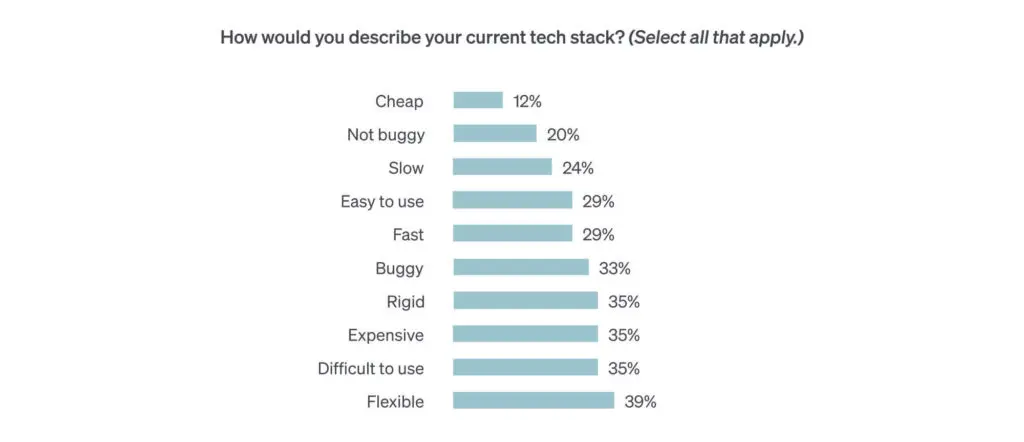
“Difficult to use” is a particularly alarming adjective for one so commonly selected. When asked what metrics their team uses to track customer satisfaction with personalized content, for example, one president/C-level executive covering marketing, communications, and customer relations responded, “We have no way to measure such things.”
A director covering marketing, communications, and customer relations agreed: “There aren’t very deep insights available in the tools we use.”
There aren’t very deep insights available in the tools we use.
Director covering marketing, communications, and customer relations
When asked about the key opportunities their business is missing out on as a result of their personalized marketing strategy (or lack thereof), a manager/supervisor covering ecommerce wrote, “We could be doing much more if we had a better solution or more bandwidth.”
In an ideal world, that “better solution,” survey respondents say, would be “easy to use,” “flexible,” and “fast.”

Given the steep costs associated with the types of technologies that can streamline omnichannel personalization, it appears that ecommerce brands haven’t been investing in the right platforms for their business needs.
“We need to configure our automated remarketing system to be more intuitive to the scope of artificial intelligence vs. having someone take reports and perform ‘automated’ marketing manually,” admits one VP covering marketing, communications, and customer relations.
But alarmingly, only 2% of ecommerce executives are pleased with their current tech stack, according to our survey.
Only 2% of ecommerce executives are pleased with their current tech stack.
“Currently, we are providing personalized experiences based on some on-site user behavior, sales history, and user input data,” explains a director covering marketing, communications, and customer relations. “We would like to invest more heavily in app-based commerce, more significant digital ads, remarketing and retargeting, and develop a more robust email personalization program.”
The biggest tech stack challenges facing ecommerce execs
In order to achieve personalized omnichannel marketing, what enterprise marketing teams need most is data—clean, reliable data on customer information and behaviors, both real-time and historical, that they can integrate across platforms and use across departments.
And right now, they don’t have it.
When asked what their teams need in order to produce the kind of personalized digital marketing that meets customers’ needs, survey respondents supplied answers like:
- “Clean data and user history/behavior”
- “Clean and actionable data”
- “Real-time, cross-device data from our API”
- “Transaction data and data captured on site”
- “Data across our various content and commerce channels synced to unified customer profiles”
Even when marketing teams have enough data in terms of quantity, it often fails to prove actionable because of its quality: it isn’t clean, it isn’t stored in a consistent format, and it isn’t easily accessible, ecommerce executives report.

In addition to data problems, enterprise marketing teams are also facing serious challenges with experimentation, testing, and budget. Here’s why, according to our survey:
1. Legacy tech stack data integrations aren’t seamless enough
More than half of survey respondents report issues with either data consistency/cleanliness or integrations, compared to only 20% who report no problems with either category.
Even when marketing teams have enough data in terms of quantity, it often fails to prove actionable because of its quality: it isn’t clean, it isn’t stored in a consistent format, and it isn’t easily accessible.
One director covering marketing, communications, and customer relations puts it simply: “We do not receive enough timely, real-time data to take action.”
Between data consistency/cleanliness and integrations, data consistency/cleanliness is a greater concern, with 59% of survey respondents classifying it as a problem with their current tech stack (vs. 53% for integrations).
However, of those who say integrations are a problem, 44% say it’s a major problem, vs. only 23% of those who say data consistency/cleanliness is a problem.
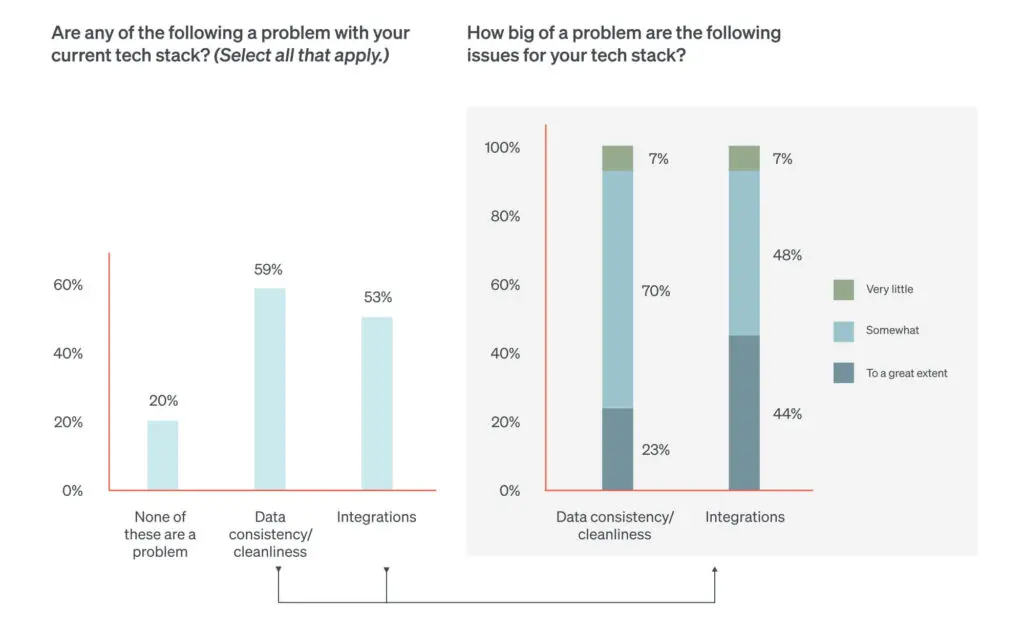
As one VP covering marketing, communications, and customer relations explains, in order to achieve personalized marketing at scale, their team needs “a modern architecture to allow us to collect all our customers’ interactions with us” and “much better master data management.”
“We need our systems to talk to each other, ideally in real time or near real time,” agrees another VP covering marketing, communications, and customer relations.
We need our systems to talk to each other, ideally in real time or near real time.
VP covering marketing, communications, and customer relations
Without reliable data integrations, it’s difficult, if not impossible, to achieve “a holistic view of how our customers engage with each different channel,” says one manager/supervisor covering ecommerce—in other words, the single customer view Campbell says is necessary to support personalization at scale.
The most difficult type of data to access, says a VP covering marketing, communications, and customer relations, is “purchase history by individual—for the most part, we only have it in aggregate.” A director covering ecommerce agrees: “The customer journey is the most difficult for us to track, along with who the customer is.”
Learn more about Klaviyo’s customer profiles
Every Klaviyo business gets a database that updates with their customers’ behaviors and preferences in real time. And then, we go one better.
We take all of that data and provide individual profiles for every customer that has ever engaged with your ecommerce store, giving you a single view into how someone has—and will—interact with your brand. It’s what makes our personalization so powerful. You can see your customers as individuals, but also communicate with them at scale.
Schedule your customized demo now.
2. Legacy tech stacks don’t allow for experimentation
Executives in ecommerce marketing are also frustrated with the restrictions their tech stacks place on creative problem solving. More than 70% of survey respondents say their current tech stack limits their ability to run experiments, A/B tests, and programs.

When asked what their teams need in order to produce personalized marketing, several survey respondents identified solutions like “better tools to do A/B testing” and “a defined testing and learning framework.”
Only 2% of survey respondents, meanwhile, say their current technologies do not limit their testing and experimenting abilities at all.
3. Legacy tech stacks are too expensive
Finally, many ecommerce executives agree they are spending too much money on their current tech. According to Campbell, legacy technologies “are too often expensive, glitchy and costly to maintain and customize,” and “require additional effort and time”—a claim our research supports.
More than half of survey respondents (53%) consider their marketing tech spend to be expensive, compared to only 16% who consider it to be inexpensive.
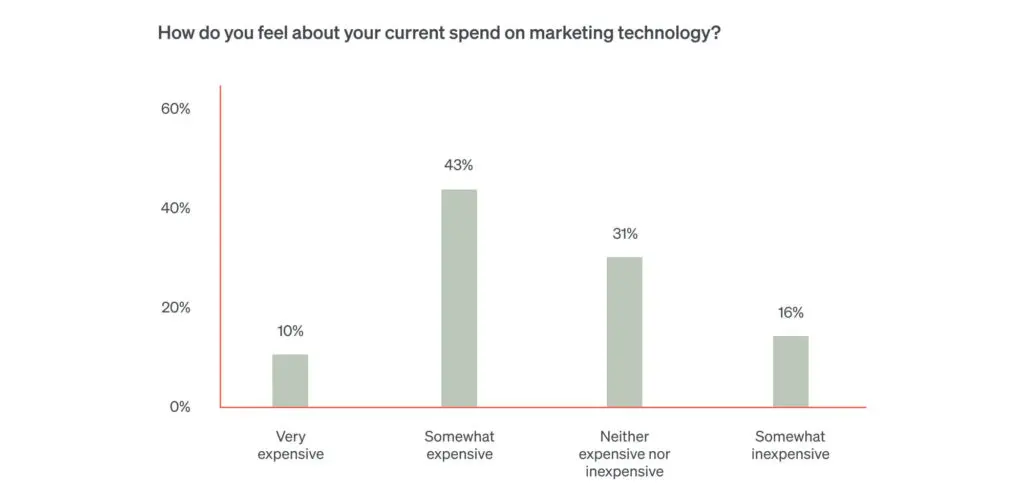
When asked what their teams need in order to produce personalized marketing, several survey respondents cited budget as a limiting factor in their answers:
- “A larger budget and more team members”
- “Design resources, marketing resources, advertising budget, and development work on our website”
- “Money and people to implement the best processes”
But considering 43% of ecommerce executives are already spending $100K-500K on their tech stacks each year and 18% report spending $1M-5M, the real pain point might lie less in restrictive budgets—and more in restrictive technology.
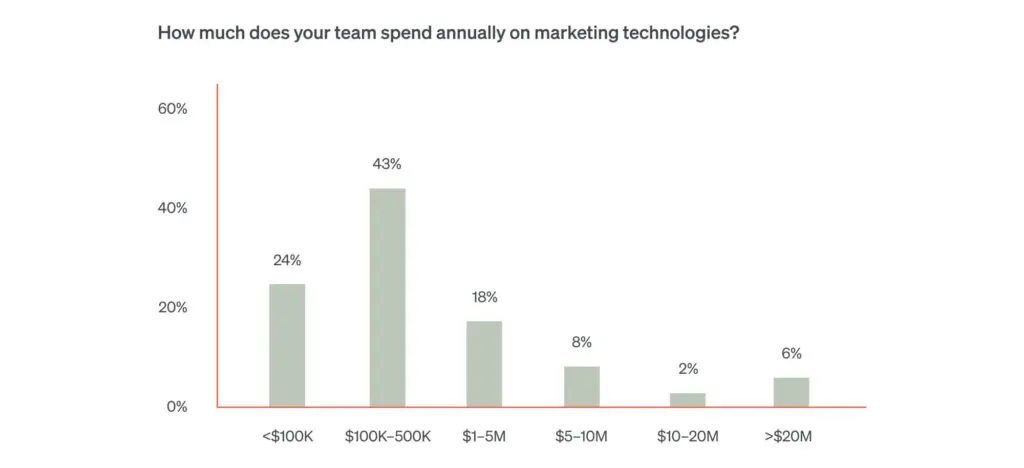
“We need better tools to help us reduce the bandwidth that is required to run personalization more efficiently,” explains one director covering marketing, communications, and customer relations. “We simply don’t have enough hands on deck to give our personalization strategy the time and attention it needs.”
Learn more about Klaviyo’s unified customer data platform
Finally, a CDP for the ecommerce industry that ingests all data into a single source of truth, and makes it actionable for your marketers to create scalable, personalized user experiences with built-in analytics, A/B testing, and automation.
Schedule your customized demo now.
What ecommerce execs plan to do about their legacy tech stacks
Instead of throwing more money at the problem, many ecommerce executives are planning to invest in new or different technology that improves efficiencies without requiring additional spend, according to our survey.
More than half (58%) of ecommerce executives at enterprise brands plan to replace their current tech stack in the next 18 months—and 33% are planning on making a switch within the next year. “We need to invest in more modern and complete platforms that provide the needed tools and mechanisms,” explains a manager/supervisor covering ecommerce.

Analytics tools, landing page software, customer data platforms, and ecommerce platforms are among the top 5 technologies businesses are thinking of upgrading this year.
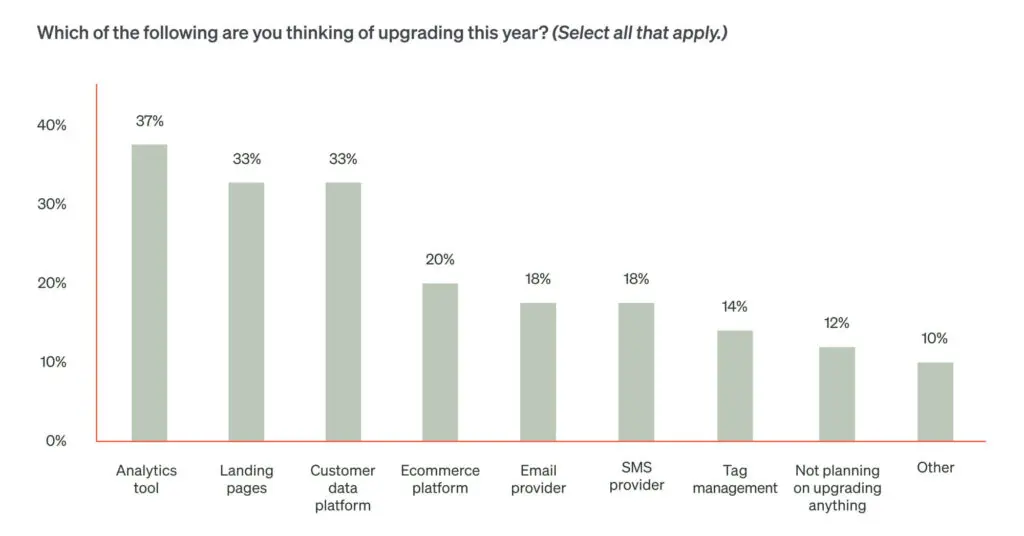
When polled about why they’re making a change, survey respondents identified data as the main culprit. And it’s no wonder—data silos resulting from the use of various point solutions, ecommerce marketing executives say, prohibit them from stitching together a comprehensive view of their data.
Considering 43% of ecommerce executives are already spending $100K-500K on their tech stacks each year and 18% report spending $1M-5M, the real pain point might lie less in restrictive budgets—and more in restrictive technology.
“We need to be able to retarget and to stop having marketing analytics siloed between departments,” says a manager/supervisor covering marketing, communications, and customer relations. “We need better CRM integration with our current CRM, Hubspot, and to update our platform so it’s fully integrated into our ecommerce platform, Salesforce,” agrees a manager/supervisor covering ecommerce.
Other top reasons for replacing tech stack elements include lack of marketing automation functionality, the desire to create an effective omnichannel strategy, and an inability to collect certain customer data or form a single view of the customer.
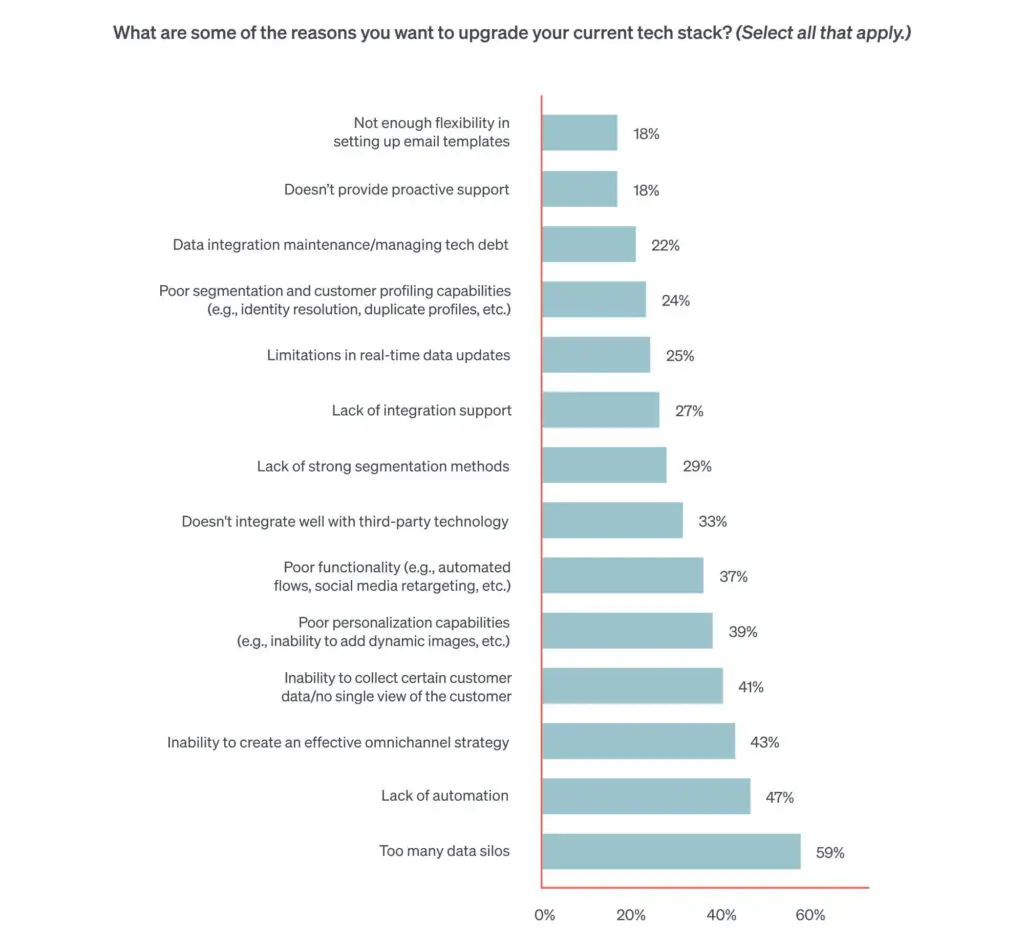
Why a CDP is the solution to your tech stack challenges
Let’s recap: Today’s omnichannel consumer is savvier than ever, and they’re looking for consistent experiences that feel 1:1—no matter the size of the brand they’re interacting with. Personalization efforts are becoming a top priority for ecommerce brands that are trying to stand out in a saturated market.
But for enterprise brands specifically, legacy systems are getting in the way. Current tech stacks are expensive and require engineering resources to maintain, and siloed data from multiple point solutions prevents brands from getting the single customer view they need to produce personalized omnichannel marketing at scale.
It’s time to make a change—and enterprise ecommerce brands aren’t waiting.
More than half (58%) of ecommerce executives at enterprise brands plan to replace their current tech stack in the next 18 months.
Abby Siciliano, senior director of business development at Tinuiti, says that while these research findings are surprising, it’s also “refreshing” to see that executives across various industries are facing the same challenges with connecting data between systems.
“It gives a sense of community and confirms for so many that it is not just an issue at their brand or with their team—it’s widespread,” Siciliano explains. “So many have taken the ‘snowball’ approach and continue to add technologies in hopes of simplification and better use, when perhaps the opposite approach of ‘less is more’ should be the norm.”
For many enterprise brands, a “less is more” approach might start with adopting a unified customer platform with a customer data platform (CDP) at its center.
[This data] confirms for so many that it is not just an issue at their brand or with their team—it’s widespread.
Abby Siciliano, senior director of business development at Tinuiti
A CDP is a packaged software that captures real-time and historical data from both internal and external systems, processes it, and then stores that information and makes it accessible to other systems.
From millions of data points collected across multiple sources, a CDP can resolve identities and create a single customer view so that a business can accurately track customer behavior over time—and, importantly, act on it.
One director covering marketing, communications, and customer relations explains it this way: “We use a customer data platform to stitch together all the IDs associated with our customers shopping on our website.”
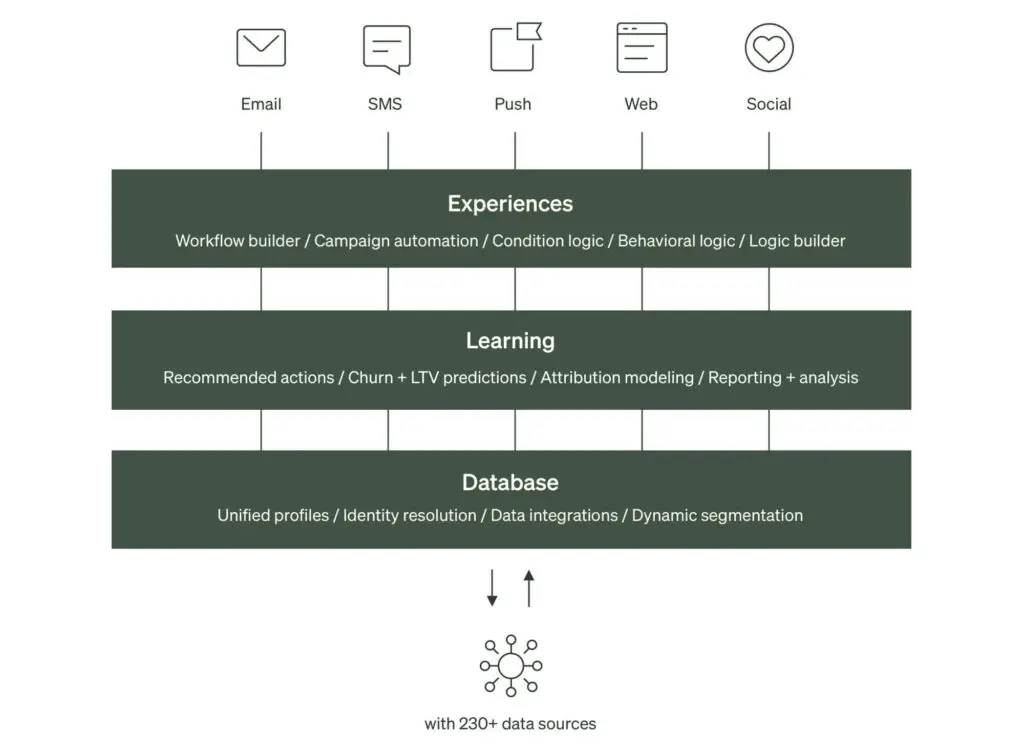
Because the data in a CDP is clean, transparent, and compliantly collected, marketers can use it to build audience segments that make it possible to deliver, cost- and time-efficiently, the kinds of experiences your customer base demands: personalized recommendations and marketing moments that feel 1:1, even if they’re 1:many.
With Klaviyo’s data infrastructure, you can unify, store, and query all from one customer database, build and automate personalized, omnichannel experiences, communicate with your customers at scale, and use your own data to drive revenue across the channels that you directly control.

Related content

Discover 8 marketing automation trends shaping 2026, from AI copilots to privacy-first personalization. Learn how brands can stay relevant, unified, and customer-focused.

From early shopping and deeper discounts to the rise of loyalty and SMS growth—discover six BFCM 2025 trends shaping this year’s peak season.

Stop wasting time debating attribution models. Learn why traditional attribution is flawed and how Klaviyo’s flexible settings help you measure true marketing impact.